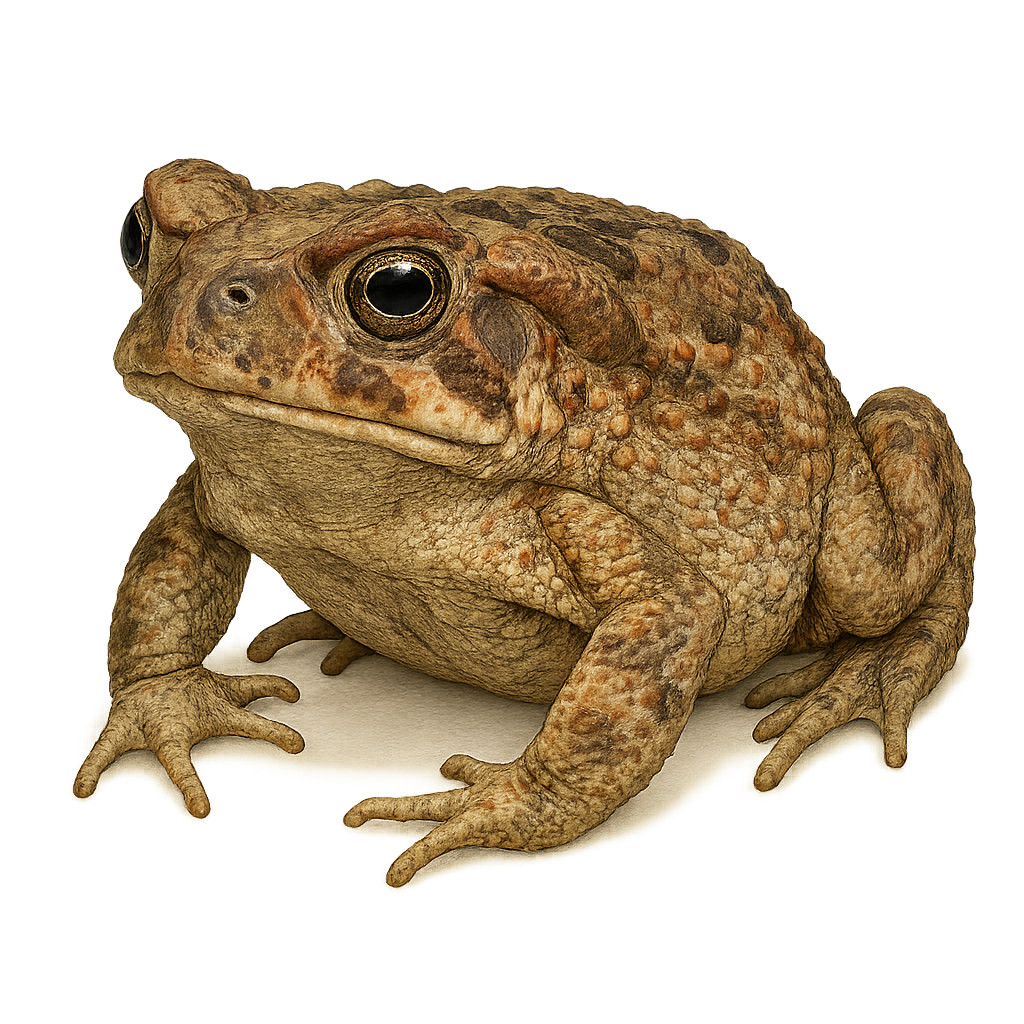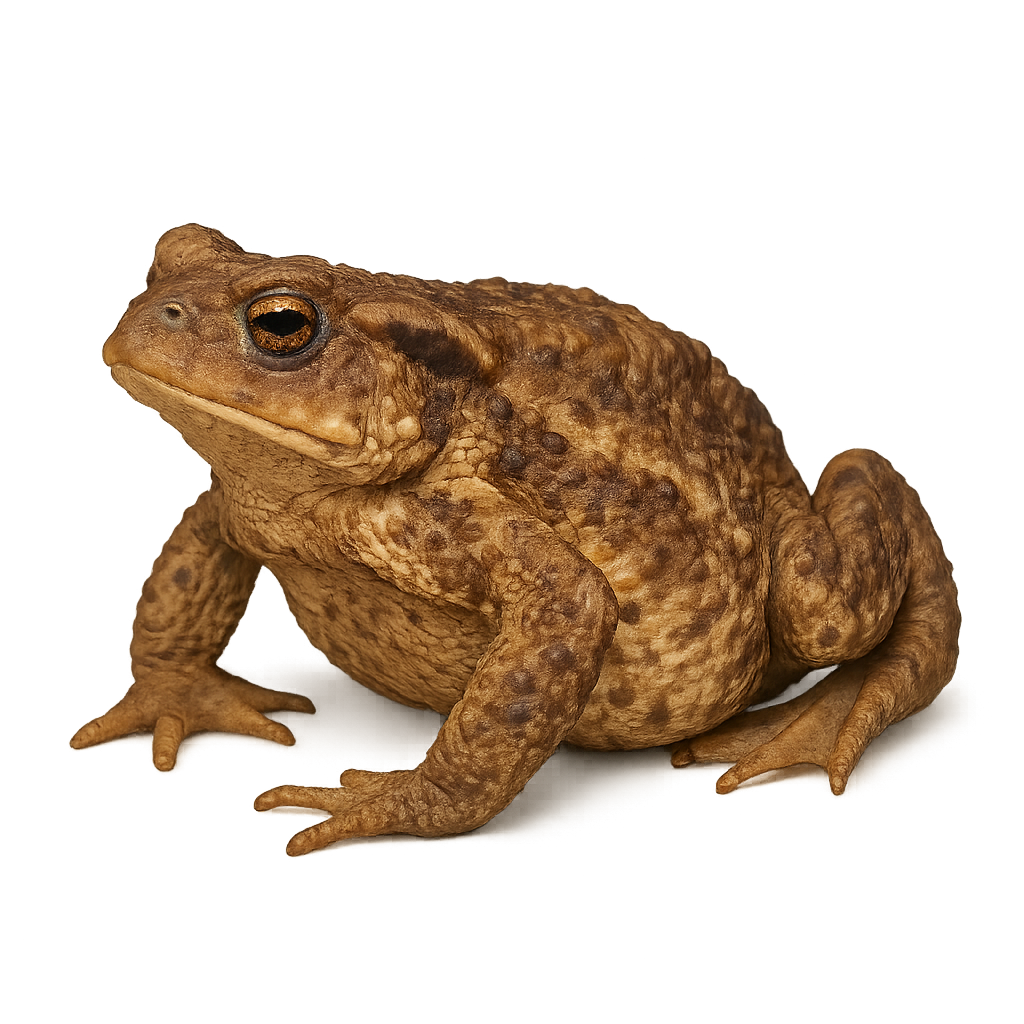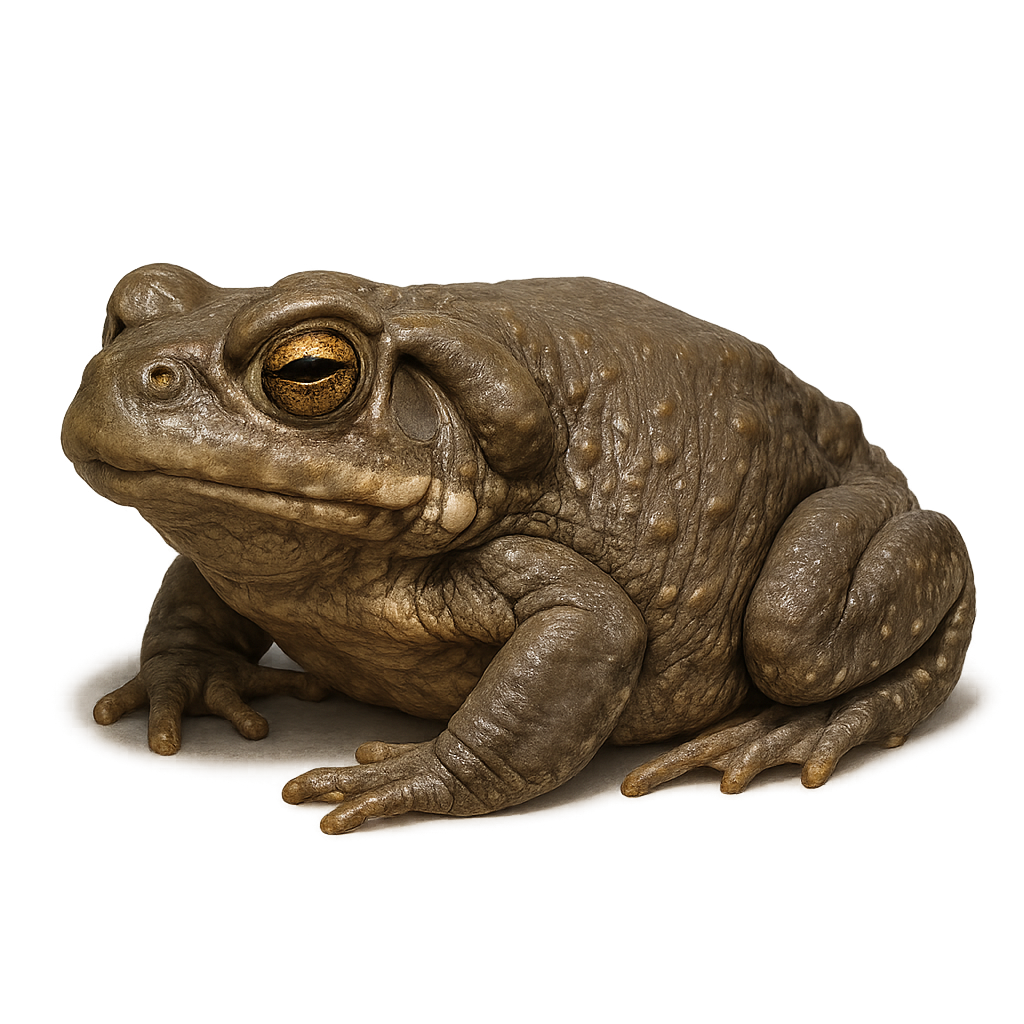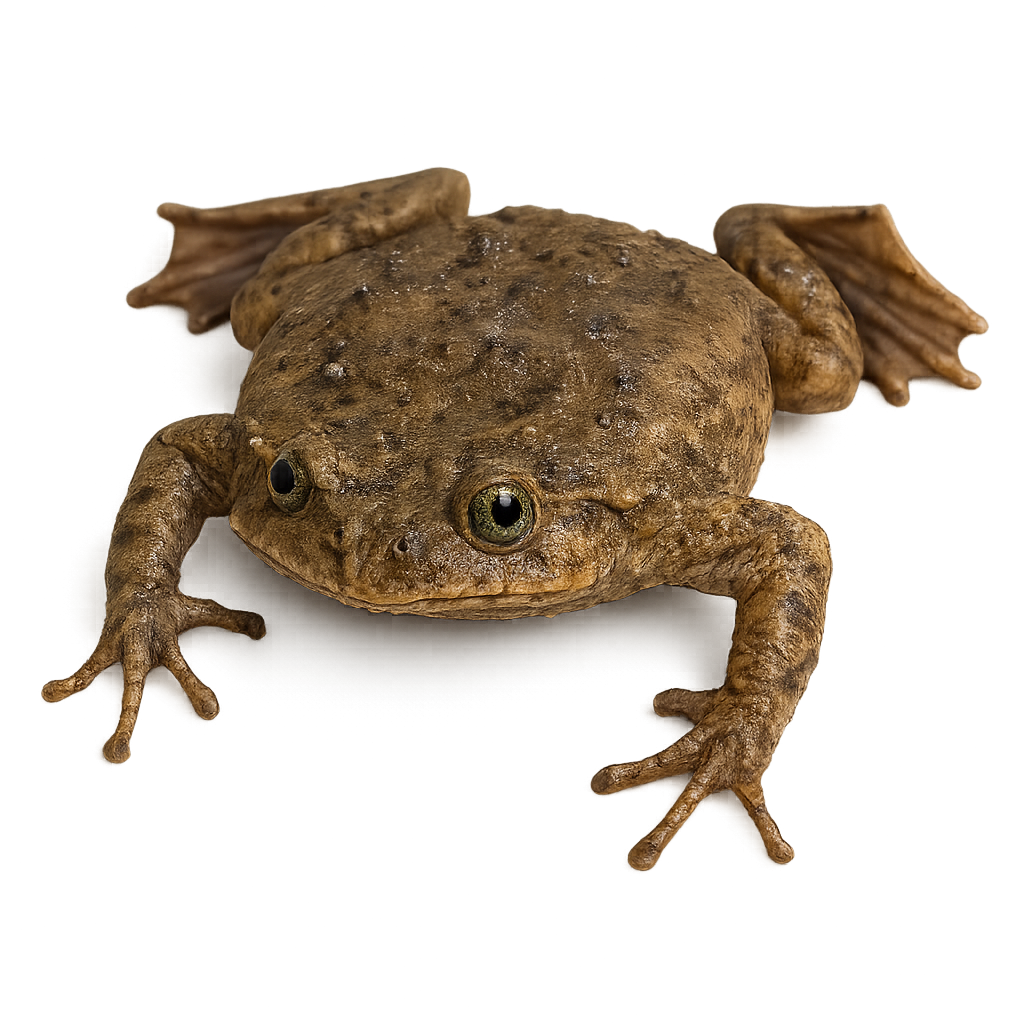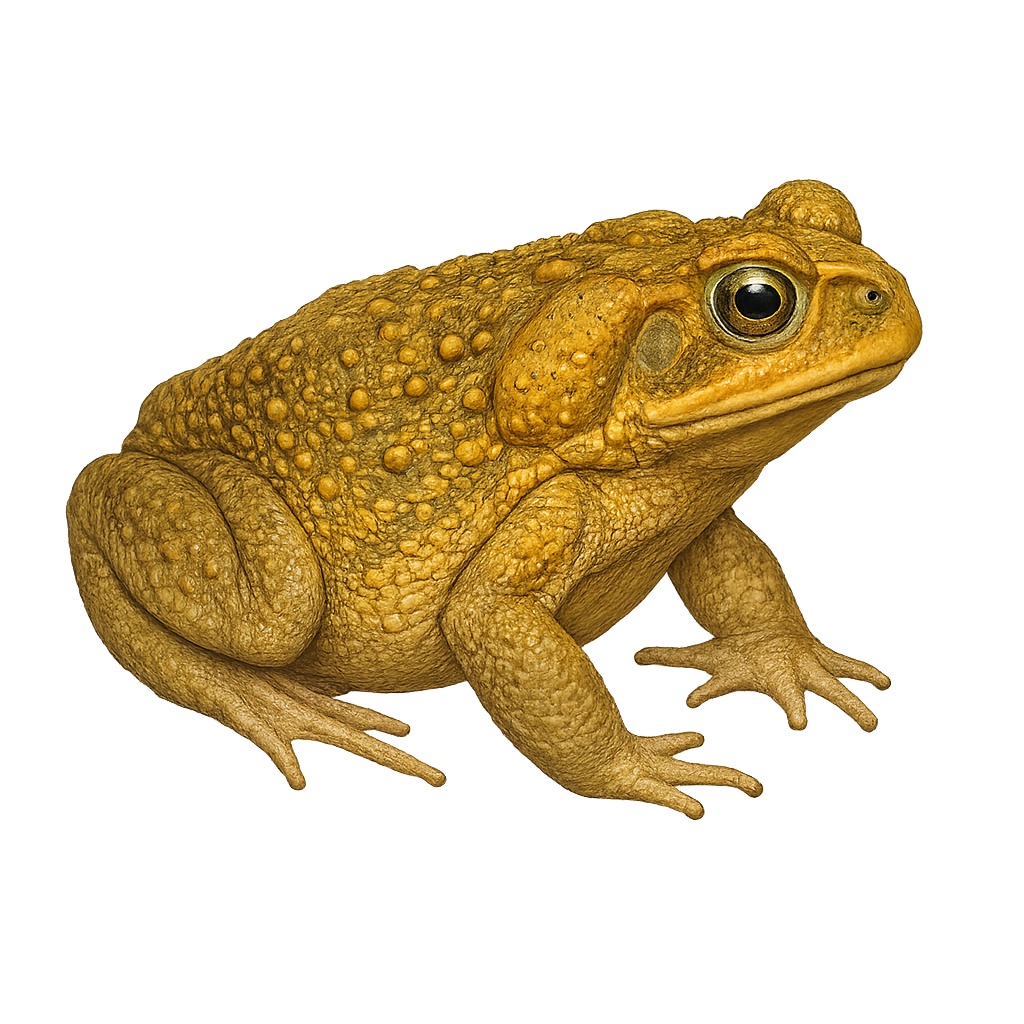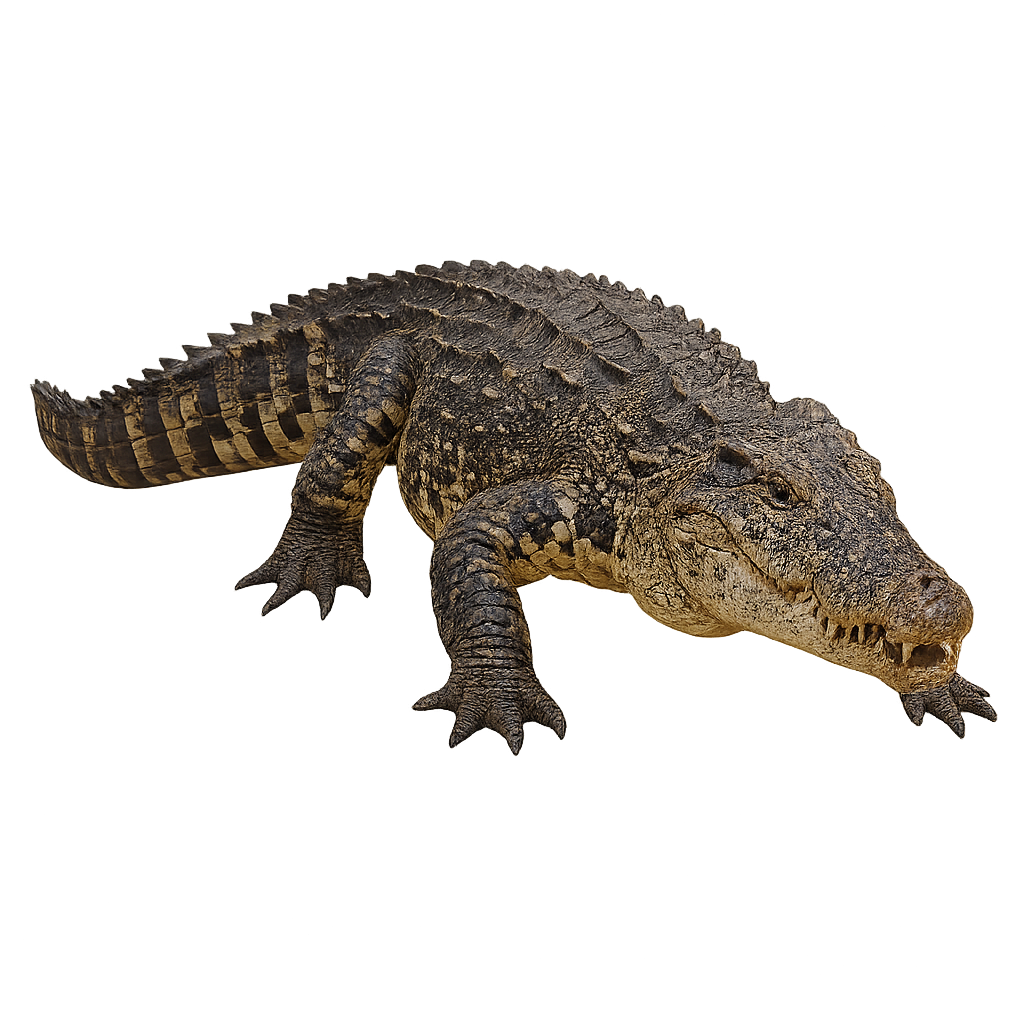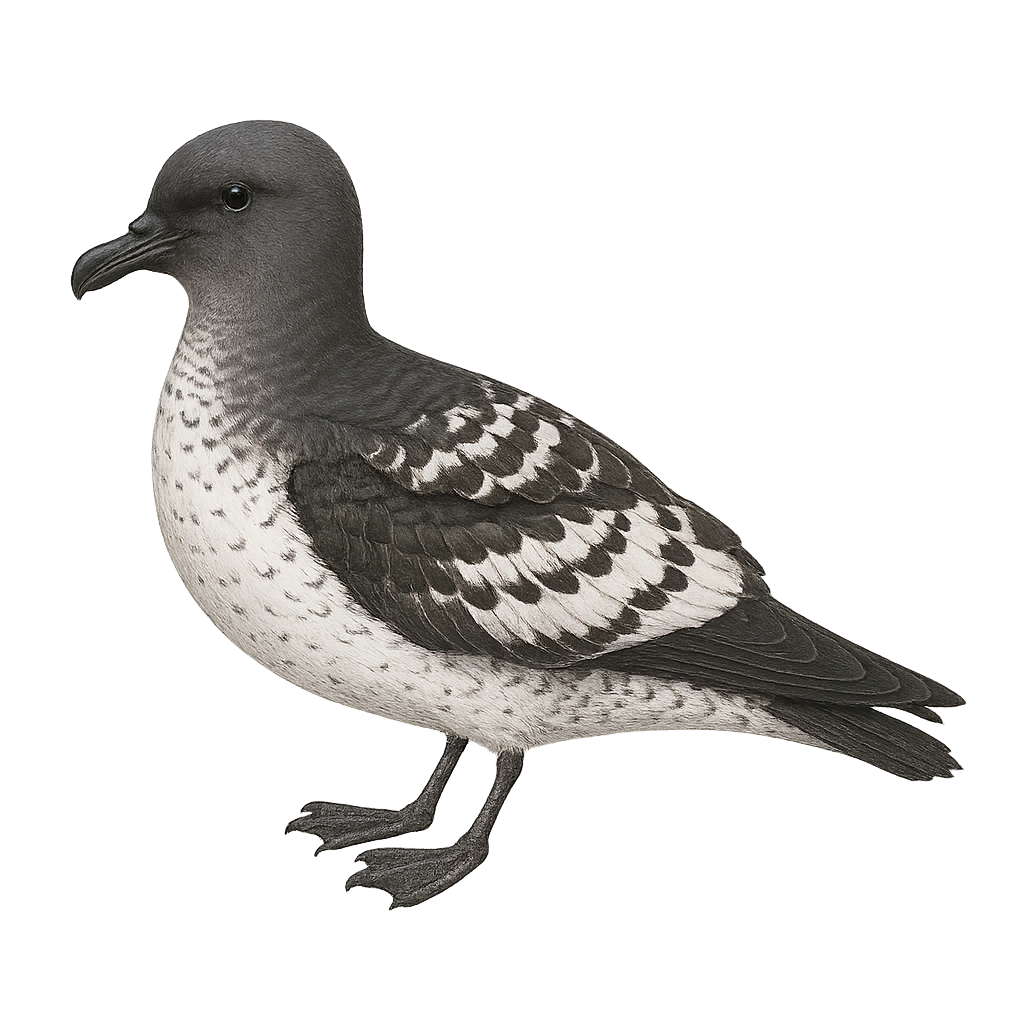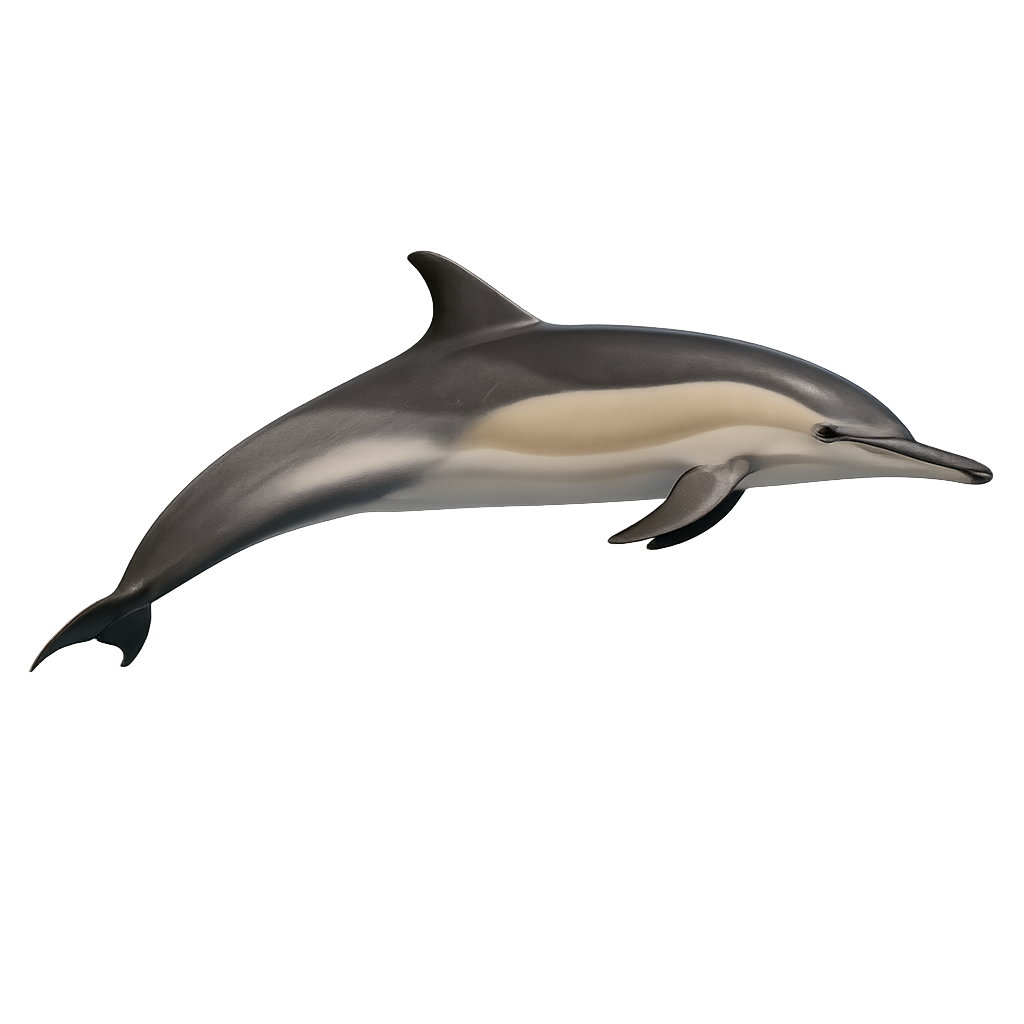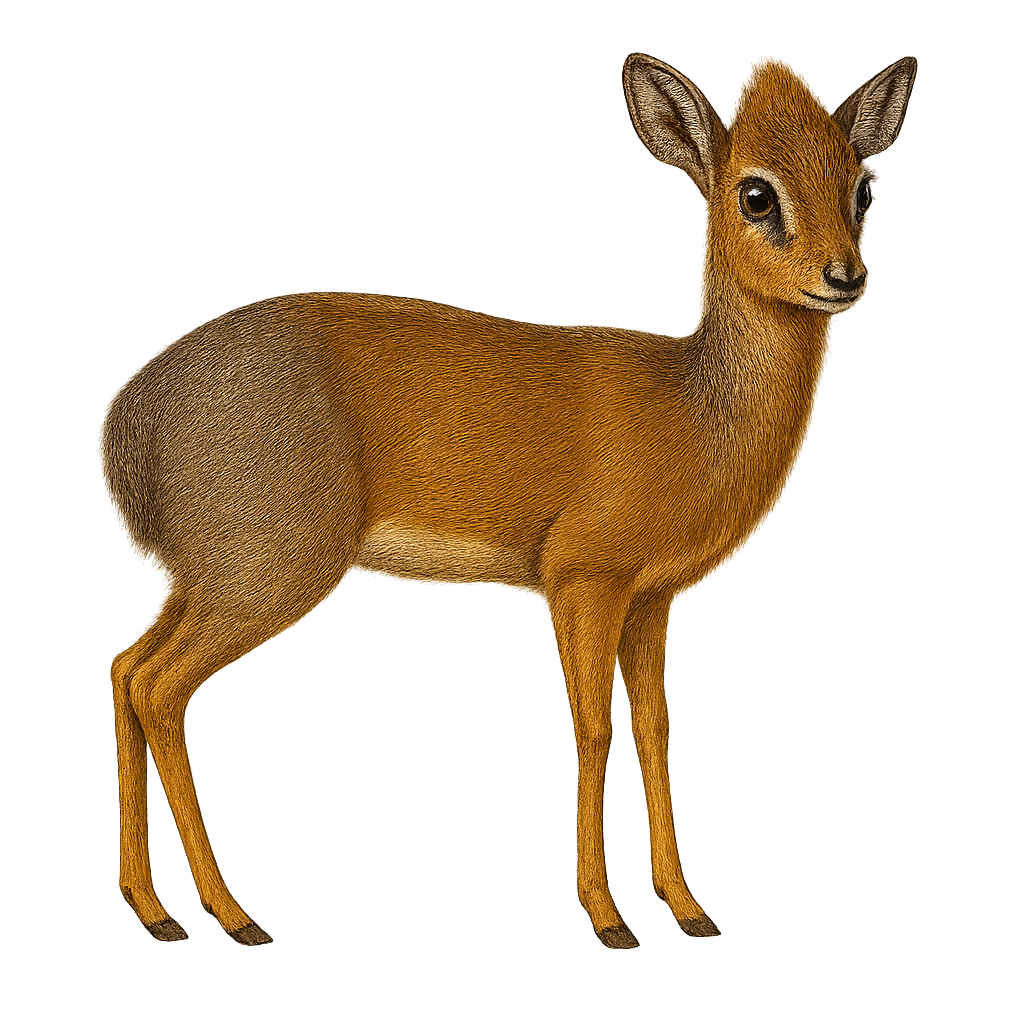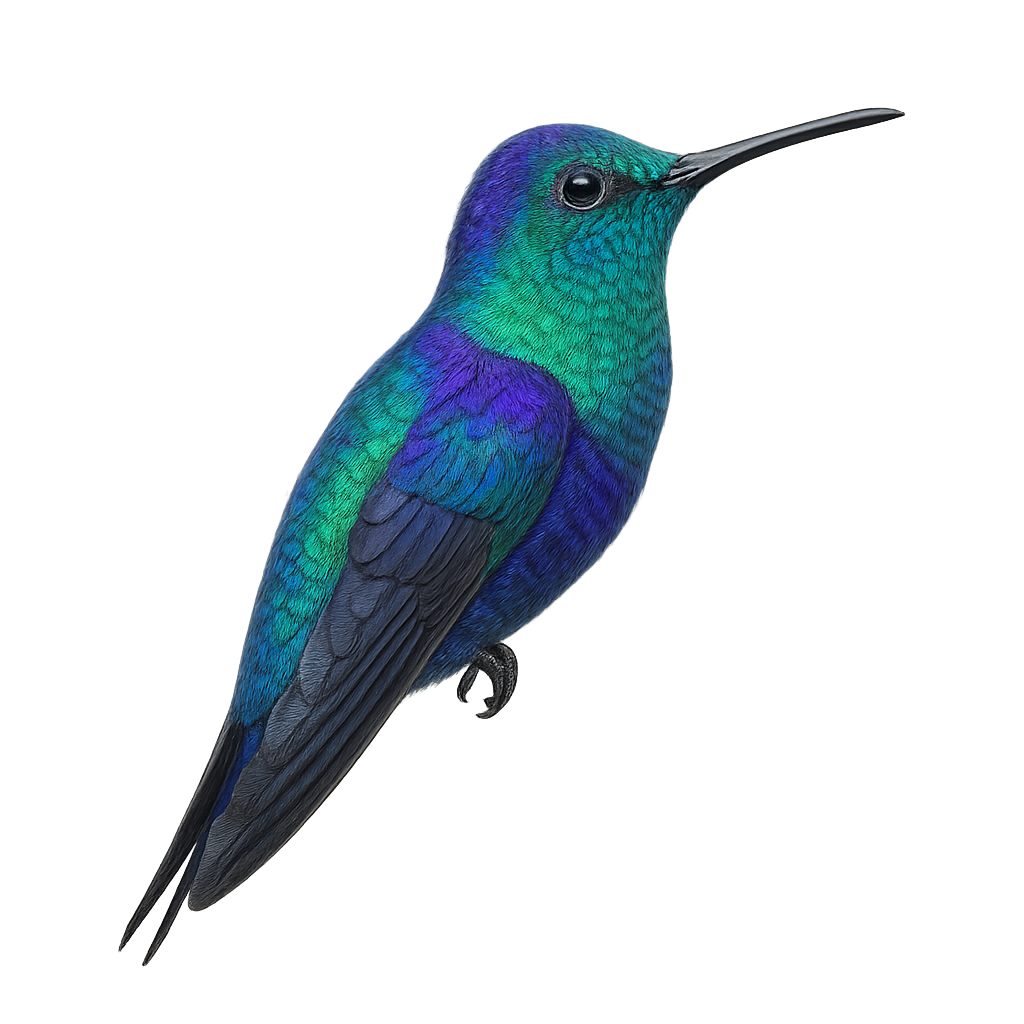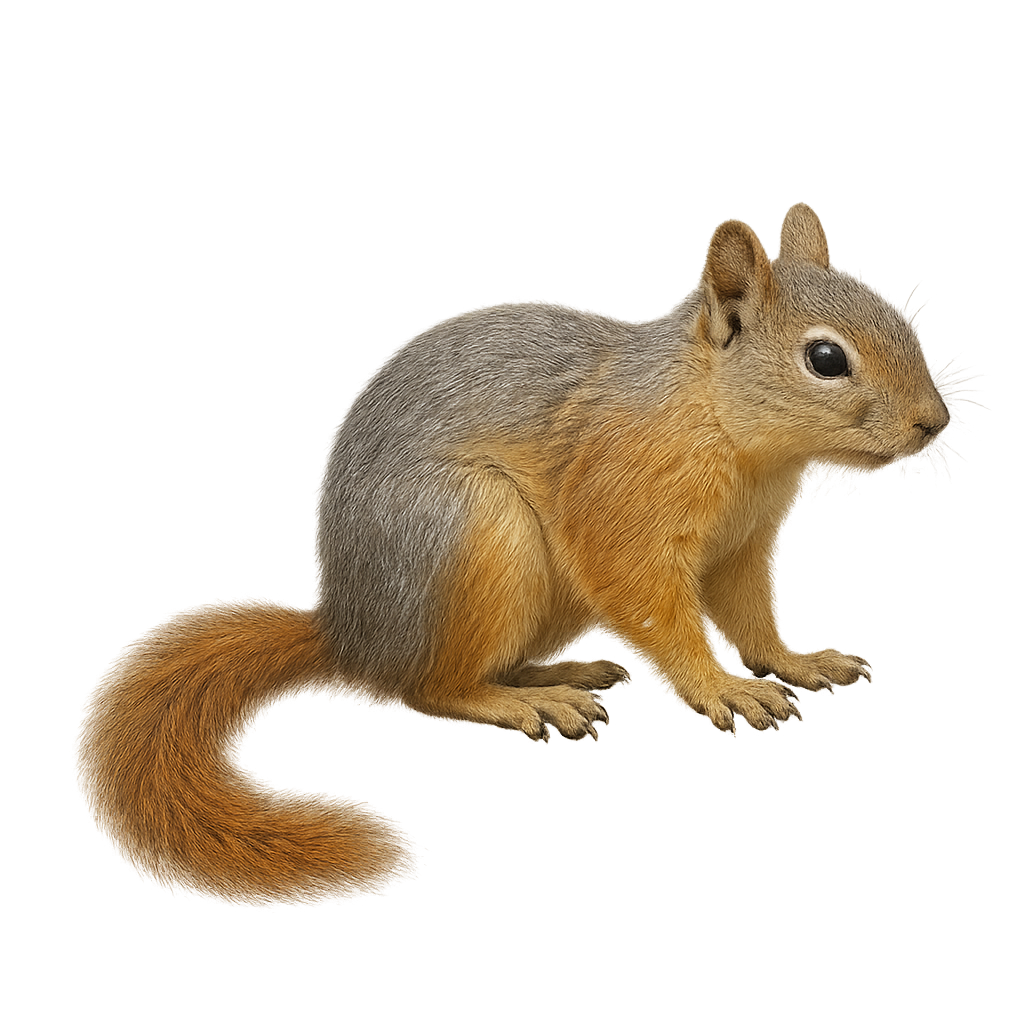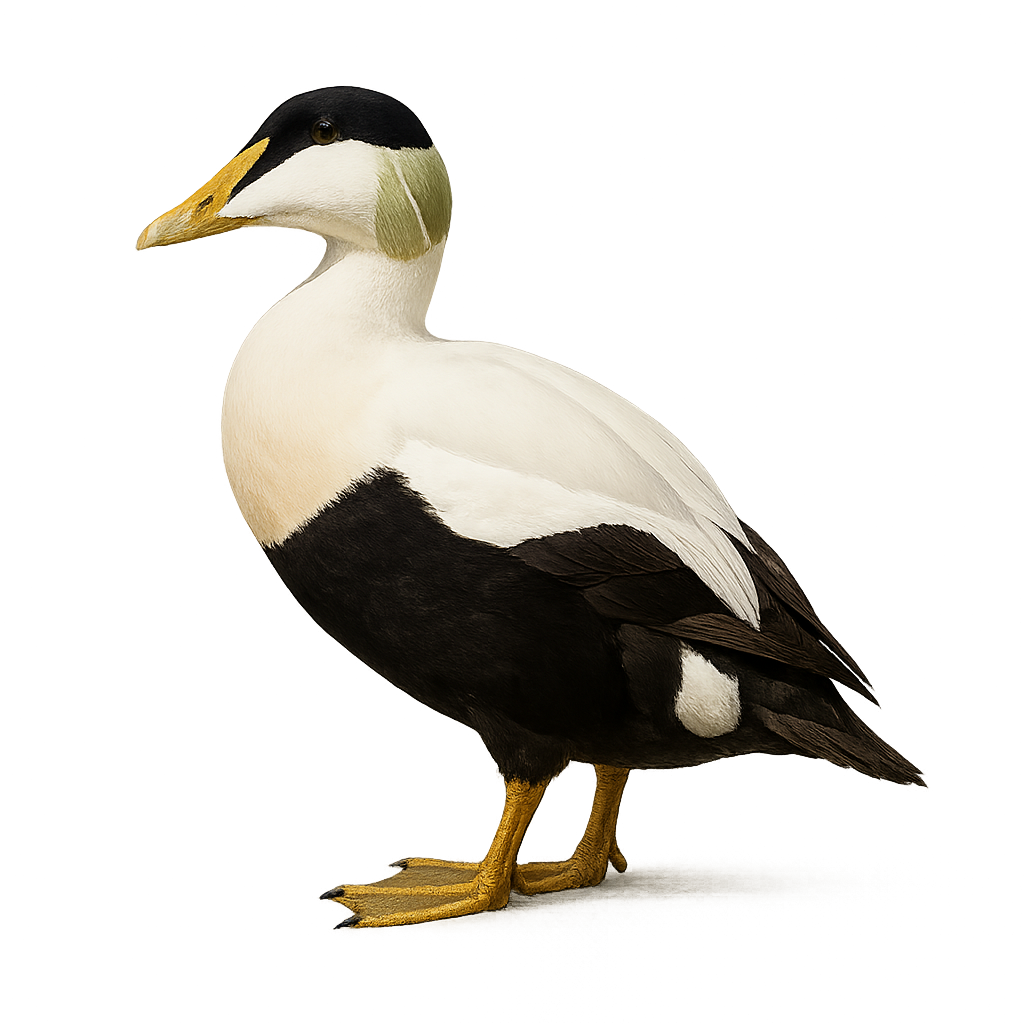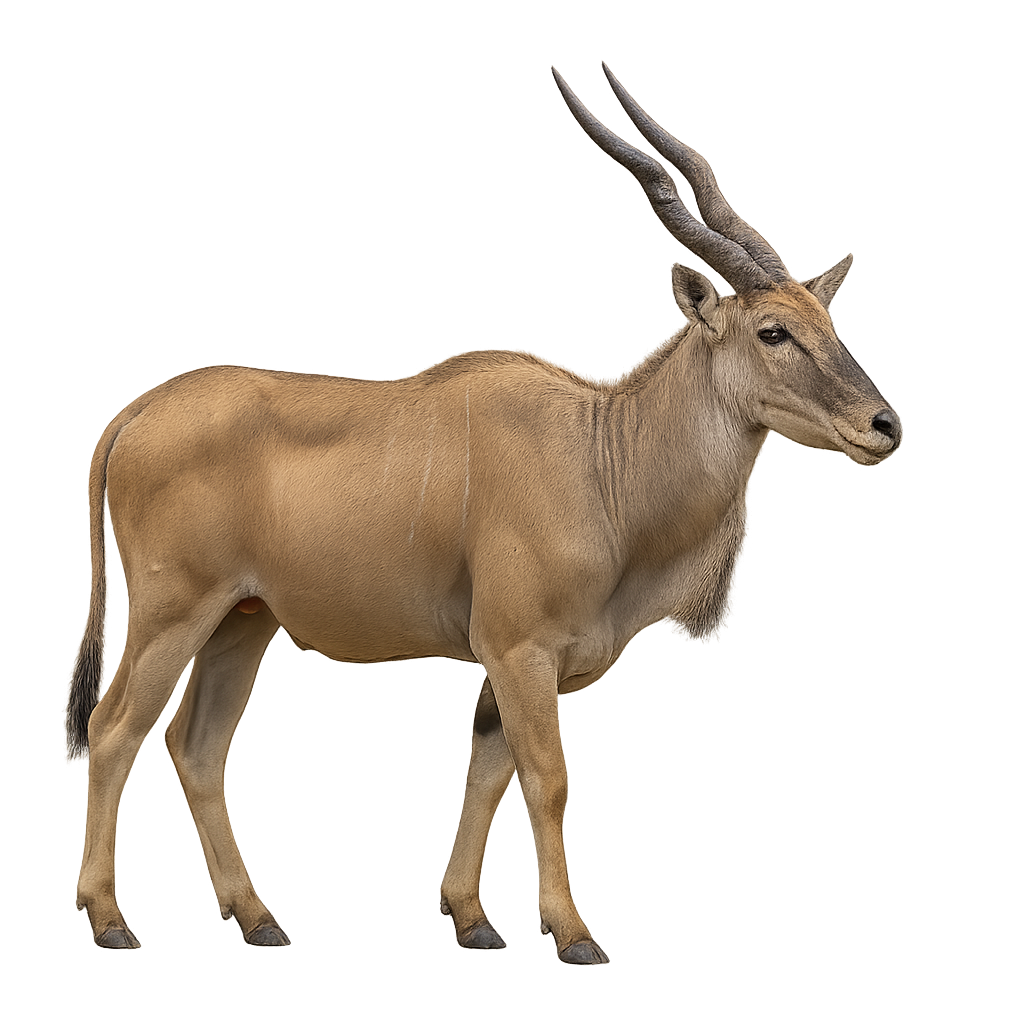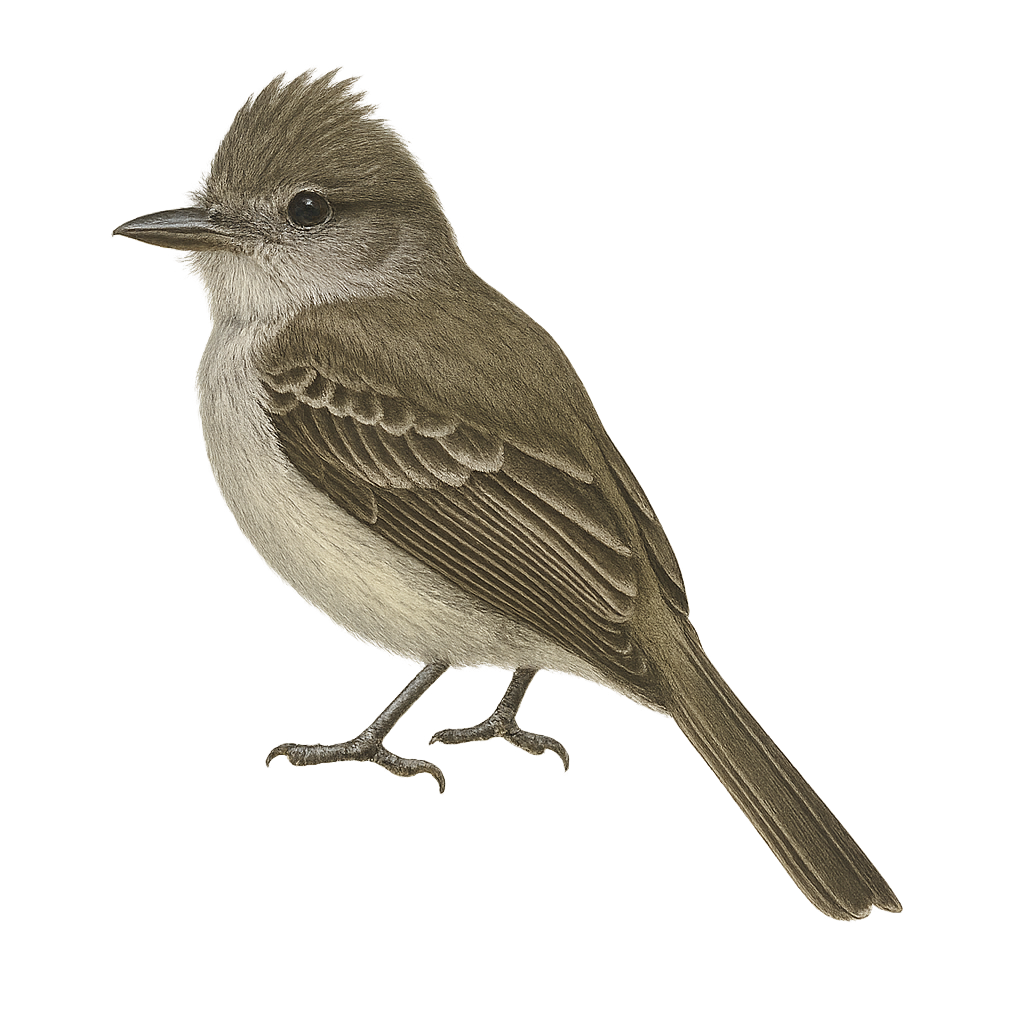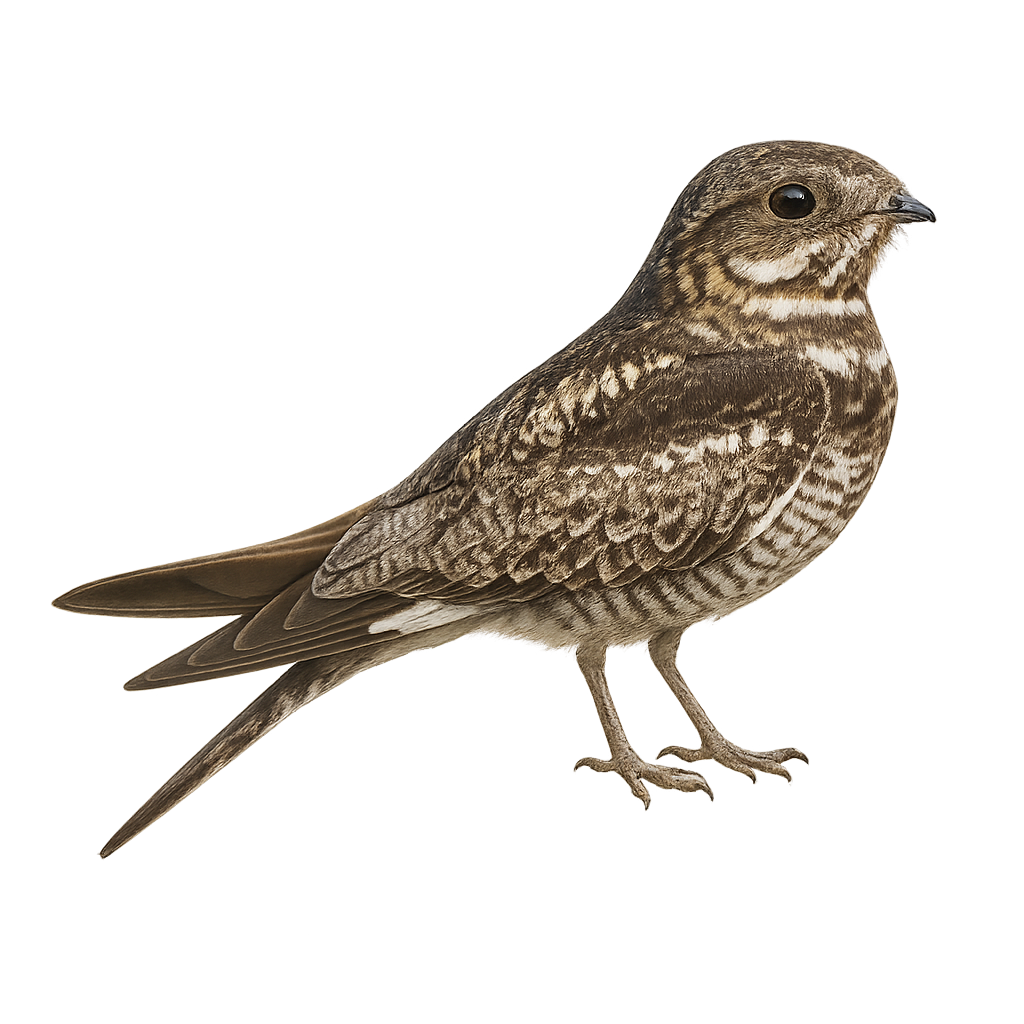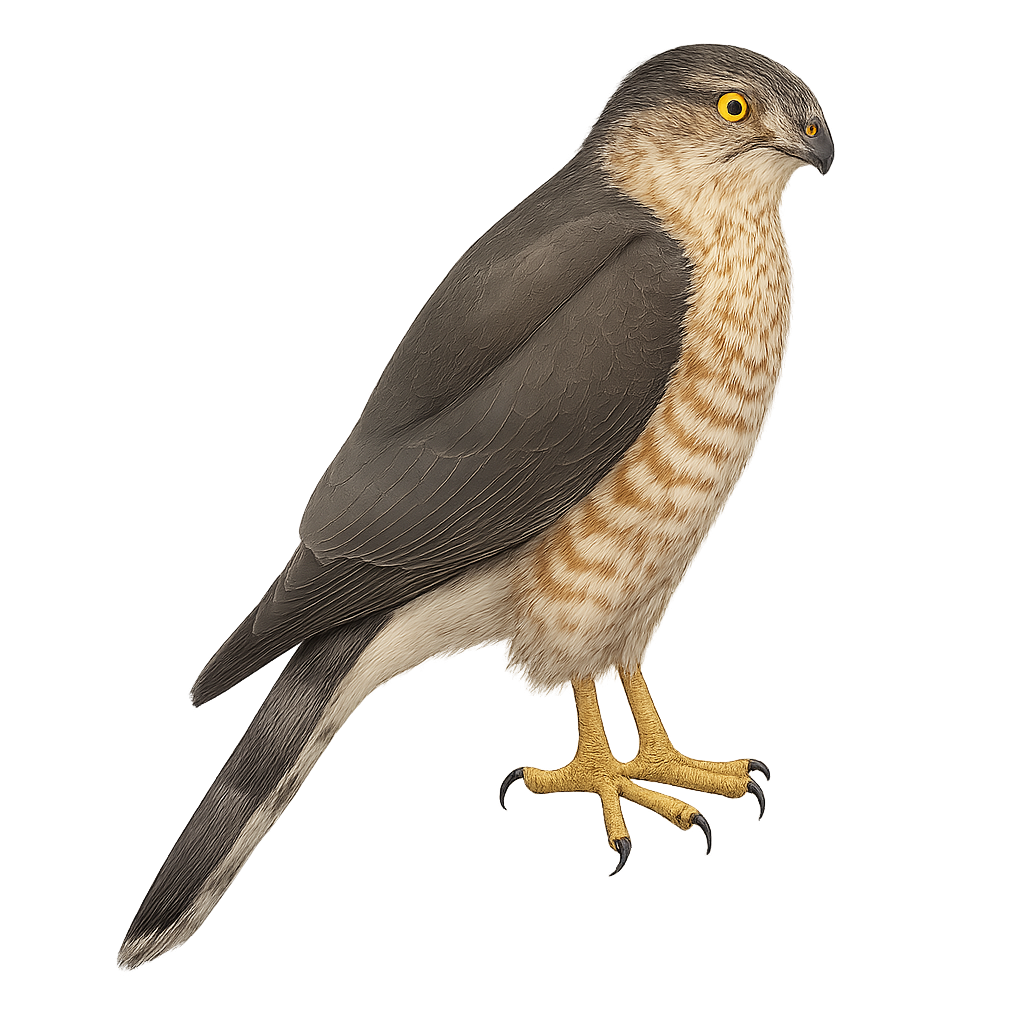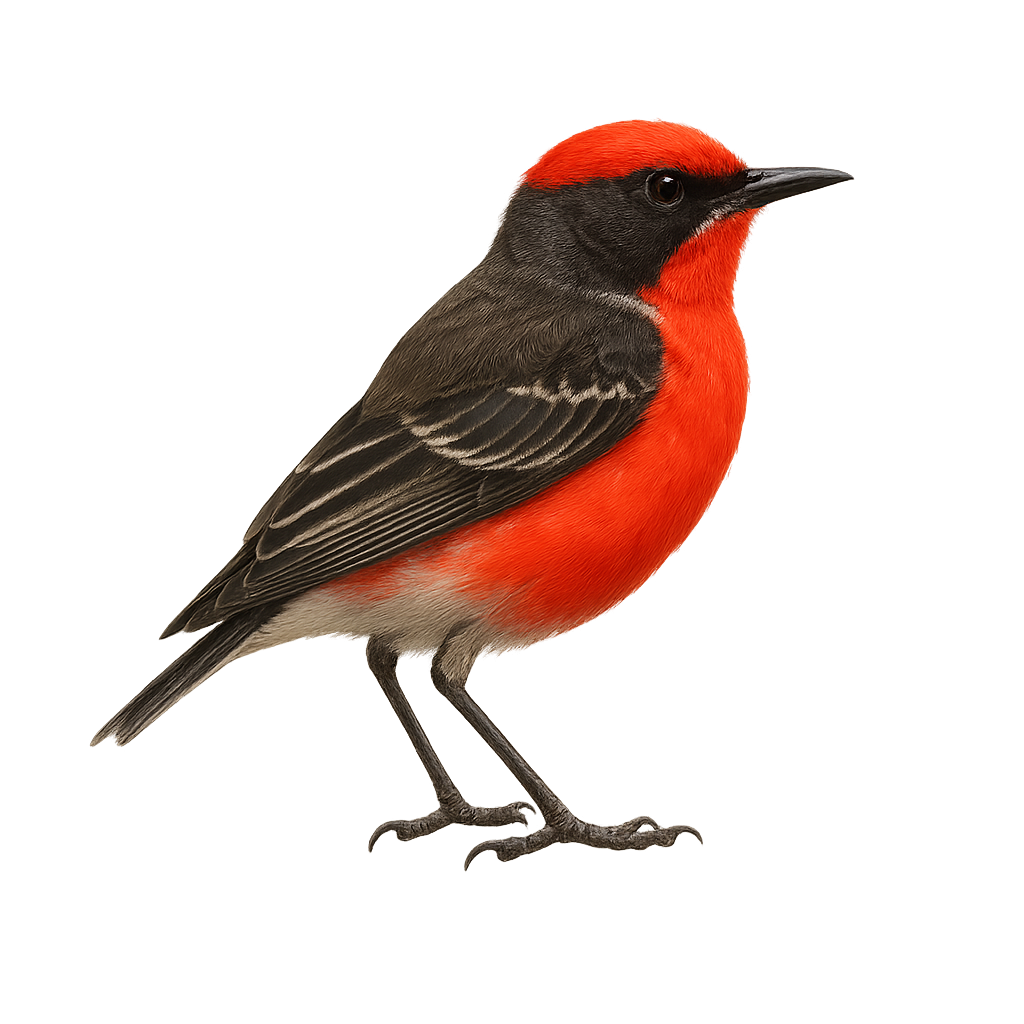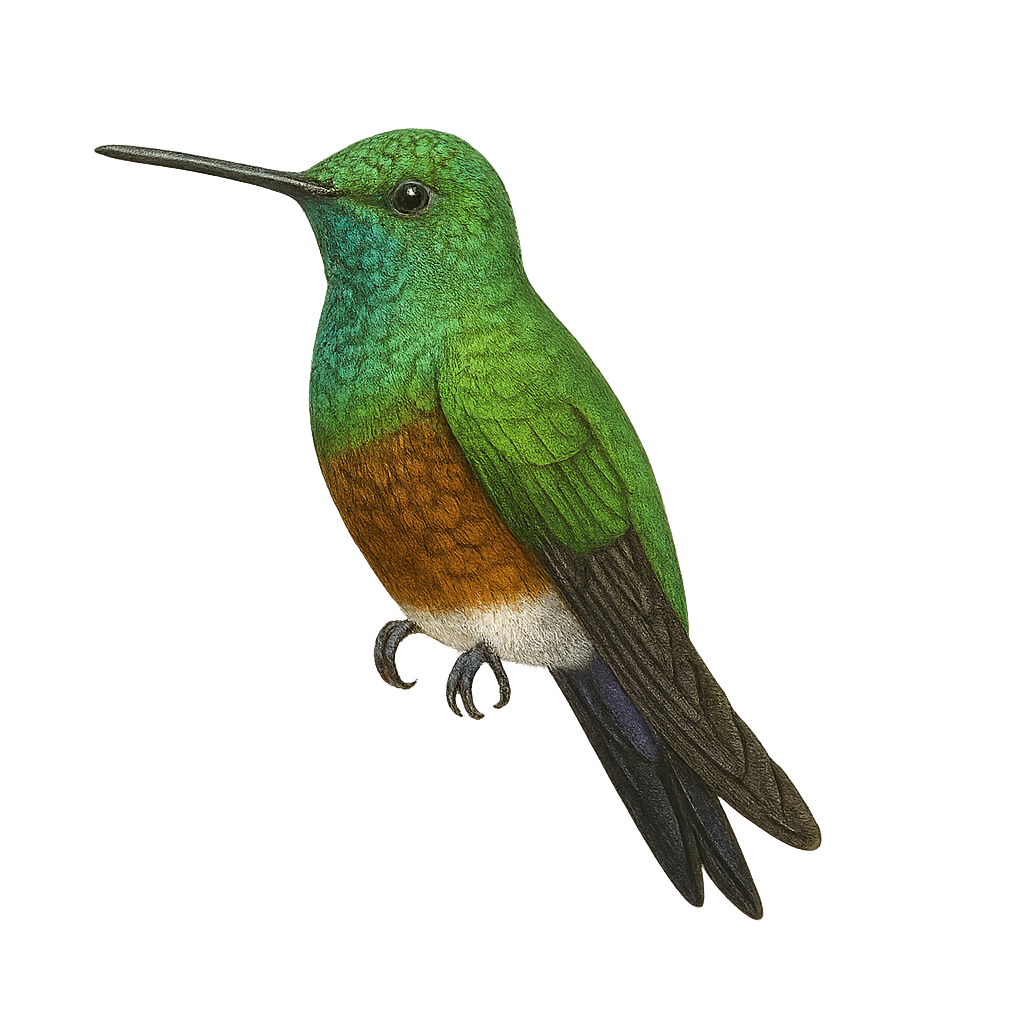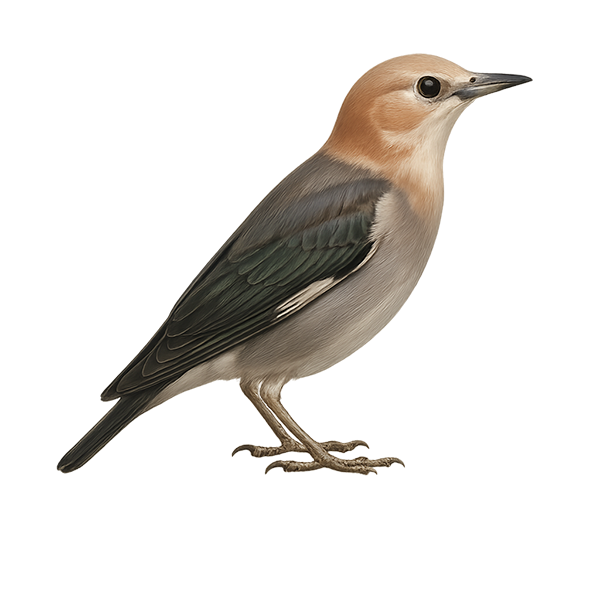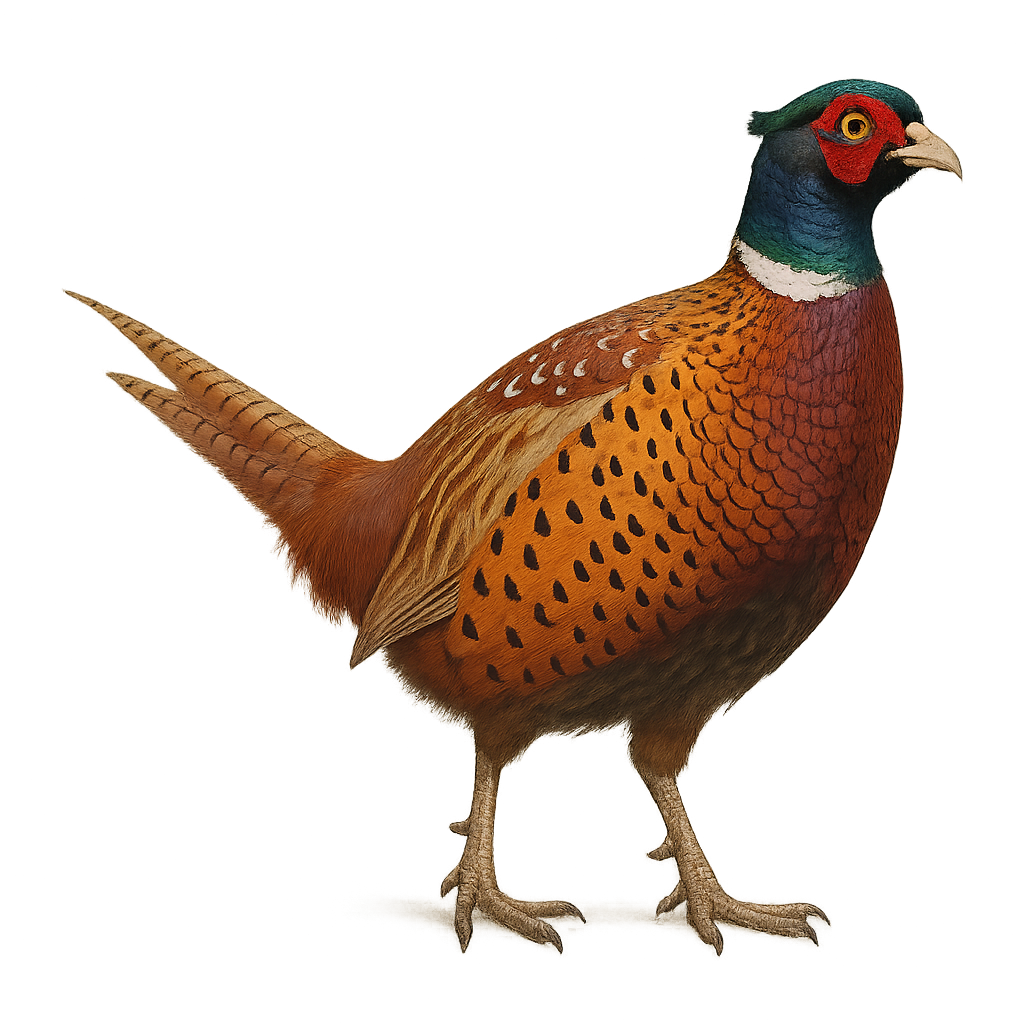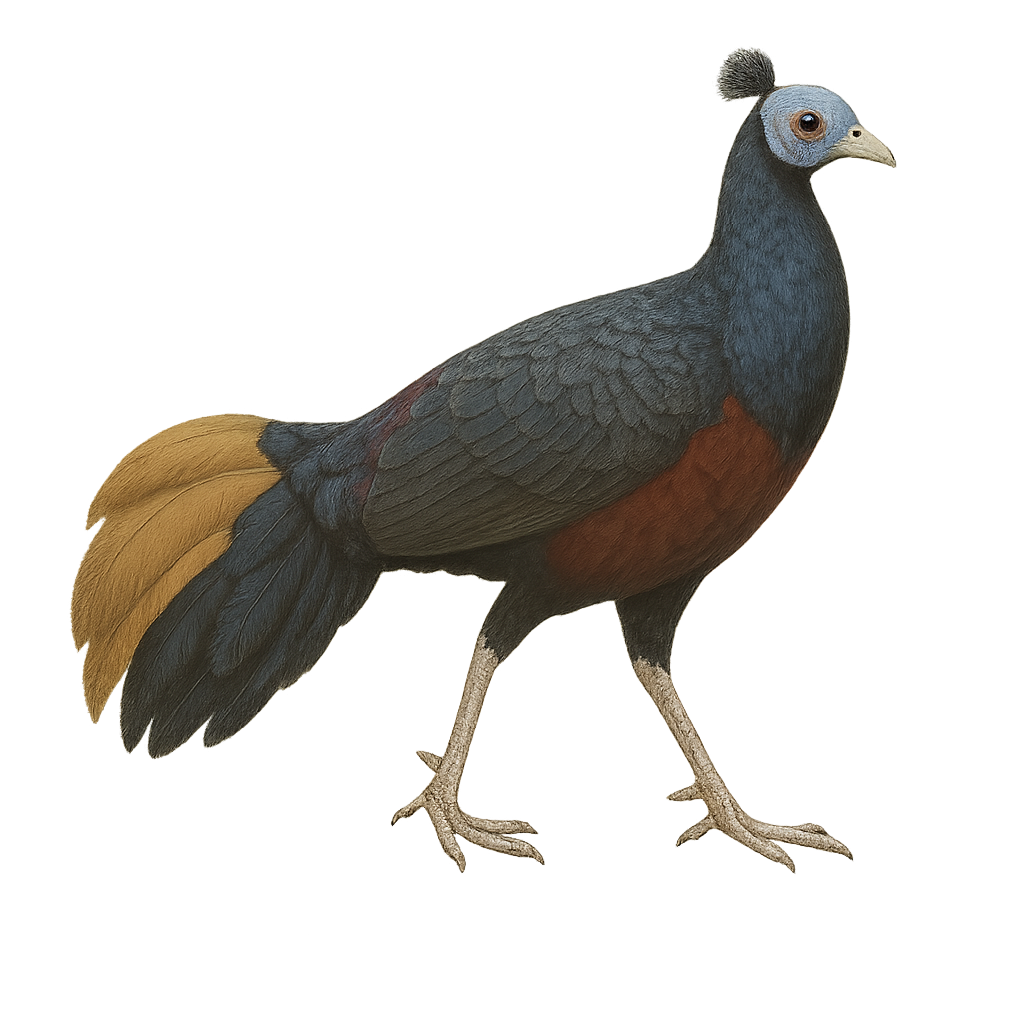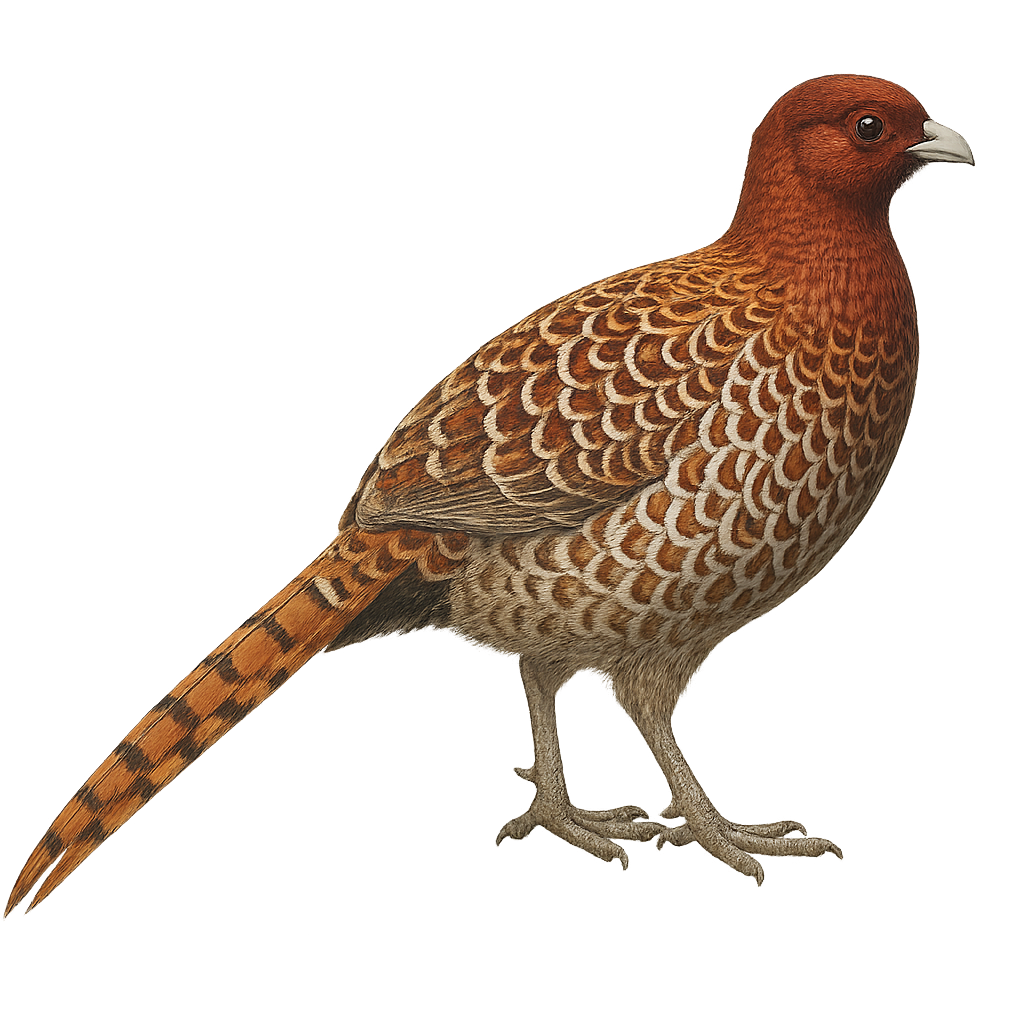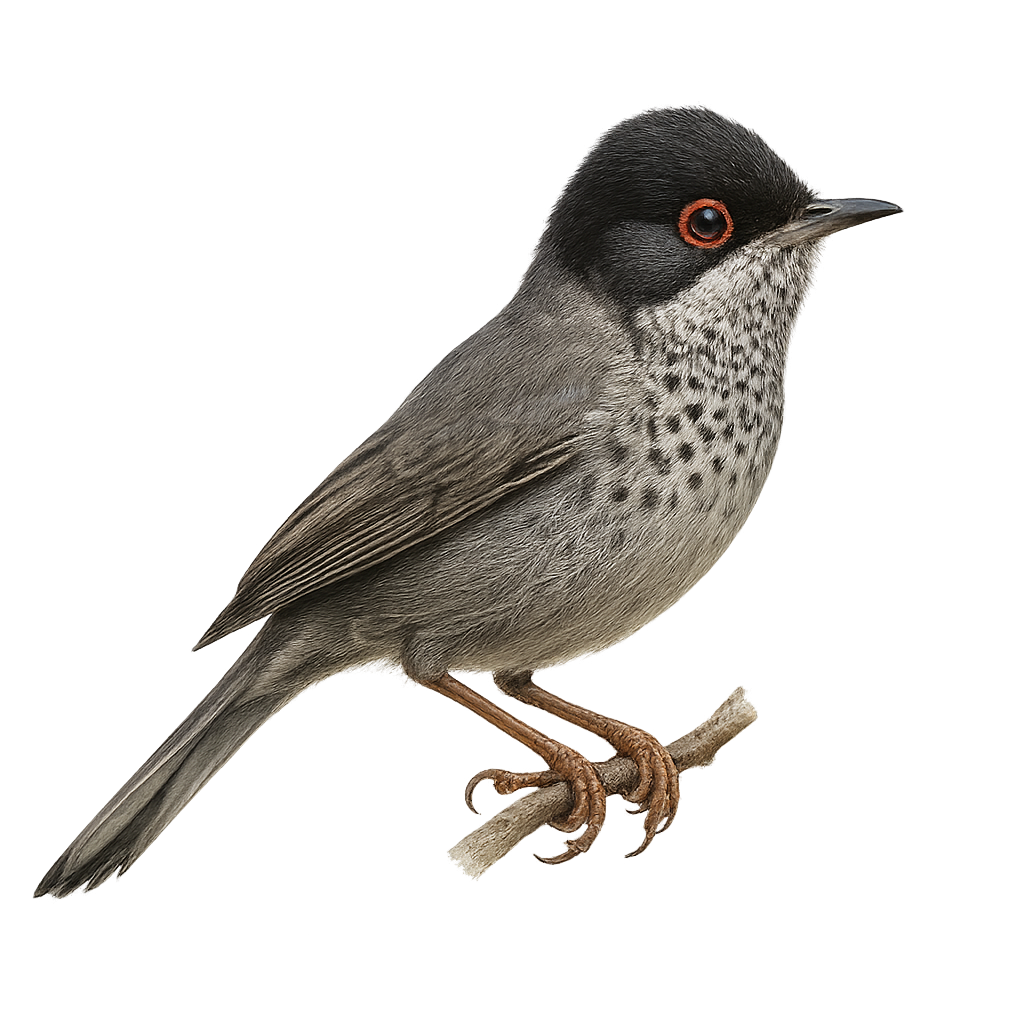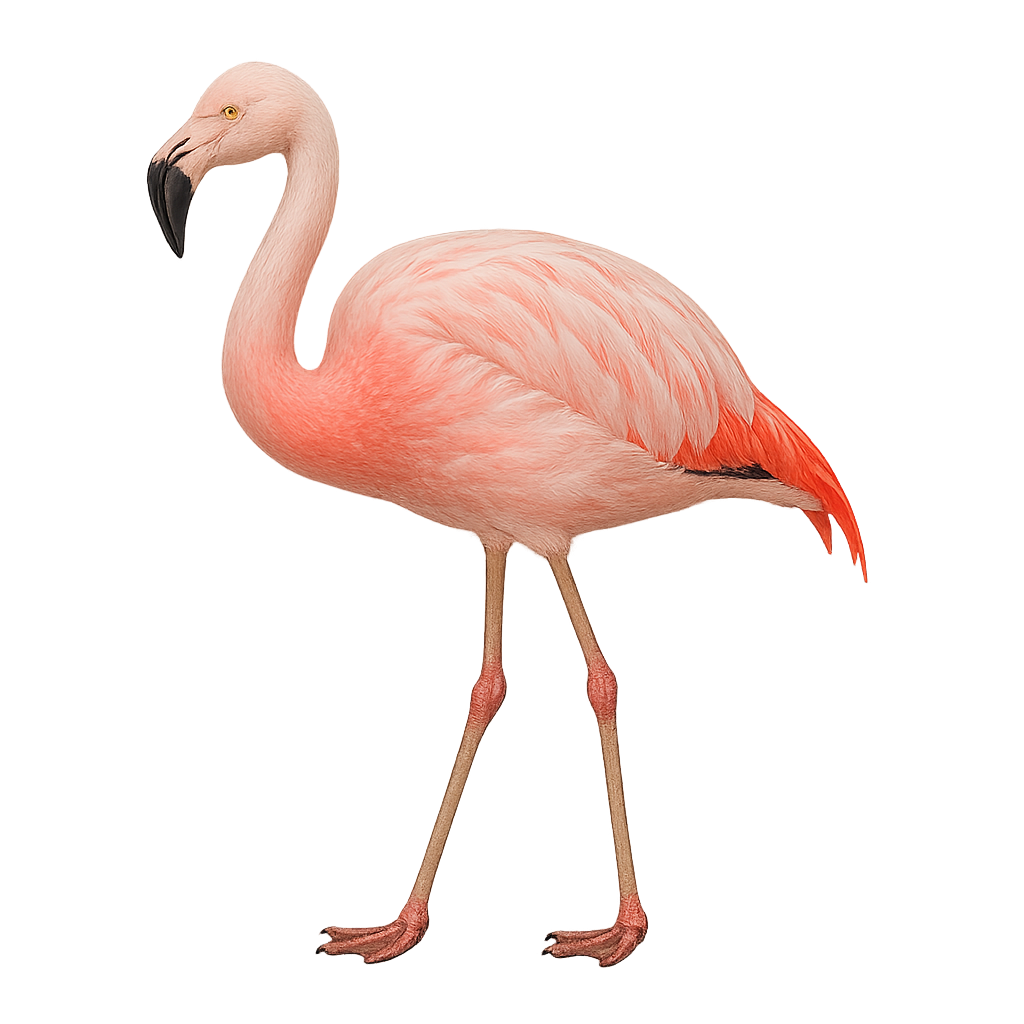The cane toad (Rhinella marina) is a robust amphibian reaching up to 23 cm in total length, with a stocky body covered in rough, warty skin colored olive to deep brown. Native to tropical wetlands of Central and South America, it inhabits marshes, rice fields, slow-flowing streams and roadside ditches, preying on insects, spiders and small vertebrates. An invasive species introduced across multiple continents, it secretes potent skin toxins to deter predators. Males vocalize in resonant choruses during the rainy season. Breeding occurs in large communal pools, where females deposit thousands of eggs in gelatinous strings that hatch in two to five days. After hatching, tadpoles metamorphose rapidly and juveniles may live over ten years.
The common toad is a sturdy terrestrial amphibian of 8–13 cm with a warty olive-brown back and a yellowish spotted belly. It inhabits damp meadows, open woodland edges and gardens, feeding on insects, spiders and worms captured on the ground. During the breeding season, males emit a low, croaking call from the water’s surface to attract females, which lay strings of eggs in double rows.
The Bufo alvarius, commonly known as the Colorado River Toad, is a fascinating species of toad found primarily in the arid regions of the southwestern United States and northern Mexico. This toad is particularly known for its large size, reaching up to 19 cm in length, and its smooth, moist skin, often speckled with dark spots. It is famous for the toxic secretions it produces, containing bufotenin, a psychoactive substance. These secretions are used by some predators as a means of defense. The Bufo alvarius is a nocturnal animal, preferring the cool hours of the night to hunt its prey, mainly insects and small invertebrates.
The Suriname Toad is a fascinating amphibian species, known for its unique appearance and extraordinary reproductive behavior. This flat and wide toad is often called the 'birthing toad' because of the way it carries its eggs on its back, where the tadpoles develop until they are ready to hatch. It primarily lives in slow-moving waters and swamps in the tropical forests of South America, particularly in Colombia, Venezuela, Suriname, and Guyana. Its flat body allows it to hide easily in aquatic substrate, and it is primarily nocturnal. Its skin is a brownish-green, and its appearance allows it to blend perfectly into its aquatic environment.
The cane toad, or Bufo marinus, is a large amphibian native to Central and South America. It can grow up to 24 cm in length and weigh over 1 kg. Its skin is rough and covered with glands that secrete a potent toxin used for defense against predators. This nocturnal toad primarily feeds on insects but can also consume small animals. Introduced in several regions to control agricultural pests, it has become an invasive species, notably in Australia, where it has caused ecological imbalances. Its ability to adapt to various environments makes it a fascinating subject of study for biologists.
The Colostethus subpunctatus is a small-sized frog species commonly found in the humid tropical forests of South America. It is characterized by its smooth skin and color patterns ranging from brown to green, often with lighter spots. This species is particularly interesting for its parental care behavior, where males carry tadpoles on their backs to safe water points. It prefers habitats near streams or wet areas, where it can easily hide under leaves or rocks. Although not endangered, it is sensitive to environmental changes, especially deforestation.
The Cuban crocodile, Crocodylus rhombifer, is a medium-sized species endemic to Cuba, primarily found in the Zapata Swamp and the Isle of Youth. It typically measures between 2 and 3.5 meters in length and is known for its distinctive scaly skin with vibrant colors ranging from olive green to yellow, with black patterns. This opportunistic predator feeds mainly on fish, small mammals, and birds. It is recognized for its aggressive and territorial behavior, making it potentially dangerous to humans. Unfortunately, this species is critically endangered due to habitat loss and illegal hunting.
The Cottonmouth, or Agkistrodon piscivorus, is a venomous semi-aquatic snake found primarily in the southeastern United States. It is recognizable by its triangular head and coloration that ranges from brown to black, often with lighter crossbands. This snake is well adapted to aquatic environments such as swamps, rivers, and lakes, but can also be found on land. It is known for its defensive behavior, widely opening its mouth to show the white interior, hence the name "cottonmouth". Although venomous, it generally only attacks if it feels threatened. Its bite can be dangerous to humans, requiring immediate medical attention.
The Cape Petrel, or Daption capense, is a medium-sized seabird known for its striking black and white plumage. It primarily inhabits the cold waters of the Southern Ocean, often seen gliding over the waves. Its short, hooked black beak is well-suited for its diet of crustaceans, small fish, and marine debris. The Cape Petrel is an adept swimmer, using its wings to propel itself underwater. It nests in colonies on subantarctic islands, digging burrows in soft soil to lay a single egg. Although its habitat is remote from human activities, it faces threats from climate change and marine pollution.
The Common Dolphin is a medium-sized cetacean, easily recognizable by its streamlined body and distinctive beak. It typically measures between 2 and 2.5 meters in length and weighs between 100 and 150 kg. This dolphin is widely distributed in temperate and tropical waters, particularly in the Mediterranean, the Atlantic, and the seas around Asia. The Common Dolphin primarily feeds on fish, cephalopods, and sometimes small crustaceans, hunting in highly coordinated groups. Its social structure is complex, with groups ranging from a few individuals to several hundred, depending on environmental conditions and the availability of food resources. It is also known for its acrobatic behaviors, such as jumping and group play, and is often seen following boats. While this species is not currently endangered, it faces threats from pollution, disturbances caused by human activities at sea, and bycatch in fishing nets.
The Cavendish Dik-dik is a small antelope found mainly in the semi-arid zones and savannas of East Africa. It stands about 40 cm tall at the shoulder, with a body length of 60 to 70 cm, and weighs between 3 and 6 kg. This small herbivore is easily recognized by its compact size, sharp muzzle, and bright eyes. Its coat is typically gray-brown, with lighter shades on the belly and distinct markings around the eyes, giving it an alert expression. The Cavendish Dik-dik is a discreet animal, often seen alone or in small family groups, preferring to avoid large human concentrations. It primarily feeds on herbaceous plants, fruits, seeds, and leaves. Its small size allows it to slip easily through bushes and tall grasses to escape predators. While the species is not currently endangered, it is vulnerable to habitat loss and pressures from human activities.
The Crowned Woodnymph, or Thalurania colombica, is a vibrant hummingbird found primarily in the humid forests of Central and South America. This small bird, measuring about 9 to 11 cm, is known for its iridescent plumage. Males display a striking blue-violet head and throat, with a bright green back. Females, on the other hand, have more subdued green and gray tones. This hummingbird is a crucial pollinator, feeding mainly on nectar but also on small insects. It is often seen hovering near flowers, using its long bill to access nectar. Although its habitat is threatened by deforestation, it remains relatively common in protected areas.
The common duiker, or Sylvicapra grimmia, is a small African antelope found in various regions across the continent. It is characterized by its modest size, reaching about 50 cm at the shoulder, and its grayish-brown coat that allows it to blend into its surroundings. Males have small, straight horns, while females are hornless. This animal is primarily solitary, although it can sometimes be seen in small family groups. It is highly adaptable, living in diverse habitats ranging from savannas to sparse forests. The duiker is an opportunistic herbivore, feeding on leaves, fruits, and sometimes bark. Its ability to survive in varied environments makes it a resilient species.
The Caucasian squirrel, or Sciurus anomalus, is a small tree-dwelling rodent found mainly in the deciduous and mixed forests of the Middle East, particularly in Turkey, Iran, and parts of the Caucasus. It is characterized by its reddish-brown fur, bushy tail, and ears adorned with small tufts of hair. Primarily active during the day, it spends much of its time climbing trees in search of food, mainly seeds, nuts, and fruits. Although generally solitary, it can sometimes be seen in small groups, especially during the breeding season. Its ability to adapt to different habitats allows it to survive in various environments, although deforestation poses a threat to its populations.
The Eider Duck is a large sea duck, easily recognized by its distinctive plumage. The adult male has a white body with a black head and neck, while the female is more muted with a brown speckled plumage. The Eider measures about 55 to 70 cm in length, with a wingspan of 100 to 125 cm, and weighs between 1.5 and 2.5 kg. It is primarily found in coastal regions of the North Atlantic, notably in Northern Europe, Canada, and Alaska. This duck primarily feeds on mollusks, crustaceans, and small fish, which it finds by diving underwater. It is also known for its social behavior, often living in large colonies during the breeding season. The Eider Duck is particularly famous for its down, a soft and insulating material harvested from the female's nests after laying, used to make luxury duvets and pillows. While the species is not immediately endangered, it is threatened by marine pollution, habitat loss due to coastal urbanization, and hunting.
The Common Eland is a large herbivorous ungulate, belonging to the bovidae family, and one of the largest species of antelope. It can stand up to 1.5 meters tall at the withers and weigh between 400 and 900 kg, with males generally being larger than females. Its coat is usually light brown or gray, with lighter vertical stripes on the flanks. The Common Eland has large, spiral horns that can reach up to 80 cm in males. It primarily inhabits savannas and grasslands in sub-Saharan Africa, where it feeds mainly on grasses, leaves, and bushes. It is a social animal, living in large groups, especially during the breeding season. While the Common Eland is currently listed as of least concern, it faces threats such as habitat loss, hunting, and competition with livestock for food resources.
The Caribbean Elaenia is a small passerine bird belonging to the Tyrannidae family. It is primarily found in the Caribbean, particularly on the islands of Martinique, Guadeloupe, and Saint Vincent. This bird features an olive-gray plumage on its back and a lighter shade on its belly, with a subtle crest on its head. It is often seen in tropical forests, forest edges, and shrublands. The Caribbean Elaenia is an active insectivore, feeding mainly on insects caught in flight or on leaves. Its song is a soft, melodious whistle, often heard at dawn.
The Common Nighthawk, Chordeiles minor, is a fascinating bird belonging to the Caprimulgidae family. This small migratory bird is known for its crepuscular and nocturnal habits, primarily feeding on flying insects caught in flight. Its cryptic plumage, consisting of brown, gray, and white hues, allows it to blend effectively into its surroundings. It is primarily found in open areas such as grasslands, agricultural fields, and urban zones. During the breeding season, it performs impressive aerial displays to attract females. Although its song is discreet, it is often heard at dusk and dawn.
The Chuck-will's-widow, or Antrostomus carolinensis, is a fascinating nocturnal bird known for its distinctive call that echoes through the forests of the southeastern United States. It features cryptic brown and gray plumage, perfect for blending into fallen leaves. This bird measures about 28 to 33 cm in length with a wingspan of 58 to 62 cm. It is primarily insectivorous, feeding on moths, beetles, and other flying insects caught in flight. The Chuck-will's-widow nests directly on the ground, often among leaves, without building a nest. Its breeding season extends from spring to summer, and it is known for its discreet behavior and ability to remain still for long periods to avoid predators.
The Cooper's Hawk is a medium-sized raptor known for its sleek body and rounded wings. Its plumage is mostly bluish-gray on the back with reddish barring on the underparts. Adults have striking red eyes, while juveniles have yellow eyes. This agile predator is often seen flying through dense forests or hunting in urban areas. It primarily feeds on birds and small mammals. Its adaptability to various environments makes it a resilient bird, although habitat destruction poses a potential threat.
The Crimson Chat is a small bird primarily found in Australia, easily identifiable by its striking plumage of red, black, and white hues. Males display a vivid red on their chest and forehead, while females are duller, with brownish tones. This bird is often seen in arid and semi-arid regions, feeding mainly on insects and nectar. Known for its adaptability to harsh environments, the Crimson Chat is a resilient species. It typically builds its nest in low shrubs, using materials like twigs and grasses.
The Coppery-bellied Puffleg, Eriocnemis cupreoventris, is a small, captivating bird endemic to the Andes in Colombia and Venezuela. This hummingbird is distinguished by its striking plumage, with a coppery belly that shimmers in sunlight. Males display metallic sheens on their backs and heads, while females have more subdued tones. Measuring about 10 cm in length, this bird is an essential pollinator in its natural habitat. It primarily inhabits cloud forests and shrublands at high altitudes. Its fast and agile flight allows it to feed on the nectar of tubular flowers, playing a crucial role in pollination.
The Chestnut-cheeked Starling, scientifically known as Agropsar philippensis, is a medium-sized bird belonging to the Sturnidae family. It is easily identifiable by its silvery-grey plumage and distinctive chestnut cheeks. This bird is primarily arboreal, feeding on fruits, insects, and nectar. It inhabits tropical and subtropical forests, as well as agricultural areas and gardens. Known for its varied and melodious vocalizations, the Chestnut-cheeked Starling is currently classified as "Least Concern" by the IUCN, although deforestation and habitat loss pose potential threats. This sociable bird is often seen in small flocks.
The Chestnut-tailed Starling, or Sturnia malabarica, is a medium-sized bird belonging to the Sturnidae family. It is primarily found in South Asia, notably in India, Nepal, and Sri Lanka. This bird is distinguished by its brownish-grey plumage with a chestnut tail and a lighter head. Chestnut-tailed Starlings typically live in groups and are often seen in wooded areas, gardens, and farmlands. They primarily feed on insects, fruits, and nectar. Their song is melodious and varied, making them pleasant to listen to. Although they are widely distributed, their habitat is sometimes threatened by deforestation and increasing urbanization.
The Corsican Mountain Newt, Euproctus montanus, is an endemic species of the island of Corsica. It is characterized by its smooth skin and brownish coloration, often speckled with darker spots. Typically measuring between 10 and 15 cm, it primarily inhabits clear streams and wet areas of the Corsican mountains. This species is well adapted to cool and humid environments and is often found at altitudes between 600 and 2000 meters. The Corsican Mountain Newt is an important indicator of water quality, as it is very sensitive to pollution. Unfortunately, it is threatened by habitat degradation and climate change.
The Common Pheasant, or Colchian Pheasant, is a medium to large-sized bird, easily recognizable by its bright colors and silky plumage. The adult male is particularly spectacular, with shiny plumage in shades of green, red, gold, and blue, and a long tail adorned with fine feathers. It measures about 70 cm in length, most of which is its tail, and weighs between 0.8 and 1.5 kg. The female, more discreet, has brown spotted plumage that helps her blend into her surroundings. Native to Asia Minor and the Caucasus region, the Colchian Pheasant has been introduced to many parts of the world for hunting and decoration. It typically inhabits wooded areas, cultivated fields, and grasslands. Its diet is omnivorous, consisting of seeds, berries, insects, and sometimes small vertebrates. The species is mainly active at dawn and dusk. While the Common Pheasant is not threatened, it faces risks such as habitat loss, excessive hunting, and predation by carnivores.
The Crested Fireback, or Lophura ignita, is a striking bird known for its vibrant plumage and elegant stance. Native to the tropical forests of Southeast Asia, it is distinguished by its vivid colors, including a metallic blue back and orange breast feathers. Males feature a distinctive crest and spurs on their legs, while females are more subdued with brownish hues. These birds live in small groups and are often seen foraging on the ground for seeds, insects, and small invertebrates. Their habitat is primarily in dense forests, where they find shelter and food. Although they are relatively tolerant of human presence, their population is threatened by deforestation and hunting.
The Copper Pheasant, or Syrmaticus soemmerringii, is an elegant and colorful bird native to Japan. This pheasant is distinguished by its richly adorned plumage of copper and gold hues, especially in males. Its long tail feathers, which can reach up to 80 cm, add to its majesty. It primarily inhabits dense forests and mountainous areas, where it feeds on seeds, berries, and insects. Although generally discreet, it can be observed during its courtship displays in spring. Its population is stable, but it remains vulnerable to habitat loss.
The Cyprus Warbler is a small passerine bird endemic to the island of Cyprus. It is characterized by its grey and black plumage, with a black cap and white throat. Males have a distinctive black chest, while females display softer tones. It primarily inhabits Mediterranean scrublands, garrigues, and open shrub areas. Its song is melodious and varied, often heard in spring. It feeds mainly on insects and small invertebrates, which it catches by flitting nimbly among branches. The Cyprus Warbler is territorial, especially during the breeding season, when it vigorously defends its space against intruders.
The Chilean Flamingo, Phoenicopterus chilensis, is a graceful and elegant bird, easily recognizable by its pale pink plumage with brighter shades on the wings. It has a long, sinuous neck and slender legs that allow it to move easily in shallow waters. Its curved beak is adapted for filtering small shrimp and algae, which make up its diet. Found mainly in the wetlands of South America, particularly in Argentina, Chile, and Peru, this sociable bird lives in large colonies, providing protection against predators. The Chilean Flamingo is a fascinating species, both in appearance and in its complex social behaviors.


